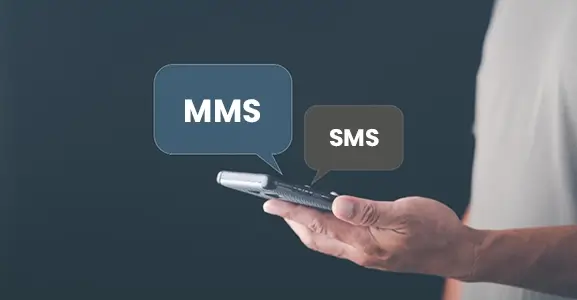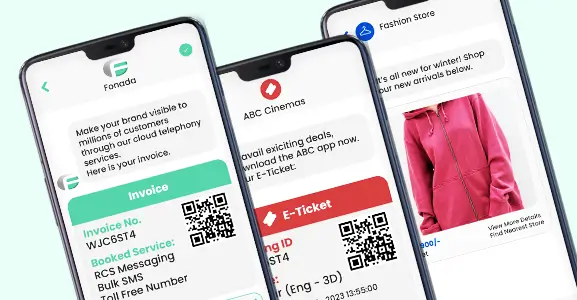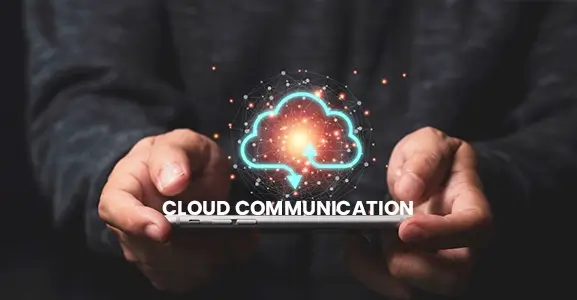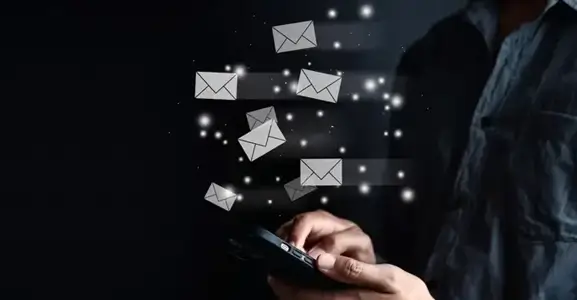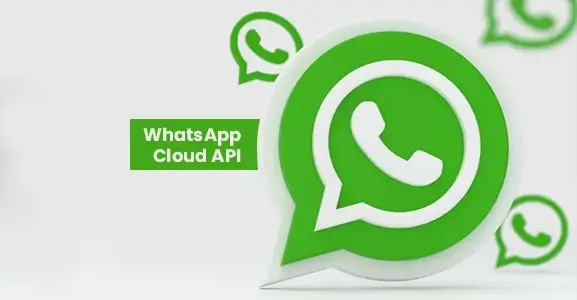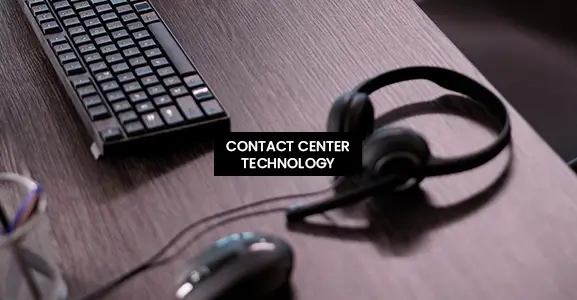We always transmit messages to others. People used to only be able to talk to each other through letters, but now there are numerous ways to send messages, such as through email, SMS, MMS, and OTT (over-the-top). MMS and SMS are the two primary methods of sending text messages through a mobile phone’s cellular data connection.
SMS stands for Short Message Service, whereas MMS stands for Multimedia Messaging Service, now the two most used terminologies in the text messaging industry. SMS messages can only feature text. However, MMS messages can include images. Both belong to the category of “text messages.” In this post, we will compare SMS and MMS, the two most common text messaging systems.
What Is SMS Messaging?
The first communications system designed specifically for text messaging was called Short Messaging Service (SMS). Developed in the 1980s, it represents the messaging services a wide range of networks and platforms provide. SMS is simple but effective. SMS is the common way to send text message technology, and over six billion messages are being sent daily.
What Are The Most Effective Applications Of SMS Marketing?
Although various alternatives have replaced SMS, it remains the most used text messaging platform for businesses. Sending an SMS message is quick, easy, and less expensive than sending a new MMS message. Your customers should not worry about extra charges for getting several texts, as most mobile plans now provide unlimited messaging. It lets brands send conversational, relevant communications to customers. Some of the best ways to use SMS marketing are:
Customer Reminders:
No-shows can be detrimental to your business, particularly if you operate a spa or salon. Send reminders to consumers regarding future appointments, special events, and product launches. SMS sending is quick, simple, and automatic, allowing you to direct your attention elsewhere.
Invoice Notifications:
Calling clients that have payments that are past due might be a hassle. Sending a text message is convenient for sending out reminders to pay, receipts of purchases, and notifications on the status of pending or delivered documents.
Enrollment Forms:
A simple SMS message, rather than one with multimedia, may be all that’s needed when all you want to do is send a link to a site or sign-up form.
Read More: Promotional SMS Vs Transactional SMS: Key Differences And Benefits
What Is MMS Messaging?
“Multimedia Messaging Service” or “MMS” messages refer to such communications. With the advent of the Multimedia Messaging Service (MMS), it is now possible to send text messages that include multimedia files like videos, photos, and web links.
A new MMS message permits photos and multimedia to appear in the text chat, but photographs sent via SMS appear as links to the media. MMS lets brands create vibrant, shareable, enjoyable content. MMS lets you communicate your brand’s story with emojis and graphics.
What Are The Best Applications For MMS Marketing?
MMS messaging allows you to improve the quality of the visual information you include in your text message marketing. Multimedia information in your texts can enhance client engagement with your business by up to 250%, making the investment worthwhile. The top MMS marketing applications include:
Promotions:
Many companies are developing SMS loyalty programs to offer loyal clients unique discounts and promotions. MMS messaging allows you to send customers redemption codes or coupons with scannable barcodes or QR codes. This also keeps your business safe because it prevents people from using these offers repeatedly.
Progress In The Product Line:
MMS messaging is a great way to tell a story and get your audience’s attention. Video content distribution is a great approach to promoting a new product to the market. Video increases consumer interest in a product.
Content With Animation:
If you like your messages to stand out from the crowd, try switching to MMS and adding some animated GIFs. MMS is useful for developing engaging content since people are more inclined to accept and share texts containing images or videos.
SMS Vs MMS: Differences
The content of your message is the primary factor of whether it will be an SMS or an MMS. Everything you include in an SMS message must be text only and fit under 160 characters. MMS permits the transmission of photos, videos, sound, and GIFs. MMS messages are often more expensive than text messages because of the larger number of characters they include.
There are three main areas where SMS and MMS difference can be categorized:
- Limits on characters
- The supported forms of media
- Pricing
1. Total Amount Of Space
SMS messages can only be sent between two devices with a maximum of 160 characters. If a message needs to be longer than 160 characters, it will be broken into multiple segments. Most carriers link communications, so they arrive in order. Users can access a vastly expanded character set when sending MMS messages, effectively allowing unlimited text and media communication. Most wireless providers limit the number of characters per text message, although these limits vary between carriers. MMS offers significantly more storage space than SMS.
2. The Role Of Media In Communication
Users can attach various media types to their messages through MMS, such as videos and GIFs. There is no need for recipients to click on website URLs to view photographs, and it is simple to share audio clips. On the other hand, SMS has limited features because it can’t send or receive multimedia. It merely sends and receives links.
3. Pricing
MMS messages are more expensive since they carry more data. Images might not always be necessary, considering that text can successfully transmit messages and motivate users to act (in the marketing context). SMS communication may be the best option for businesses that need to send quick messaging and have customers engage on certain links. However, MMS may be the best option for businesses that want to capture consumers’ attention, send images, and can manage the additional cost.
Usage SMS Messages Vs MMS Messages
SMS and MMS communications are options for businesses to use just like they are for consumers. But they serve distinct purposes, and confusing your customers by mixing them up could jeopardize your SMS messaging campaign. Even if messages are similar, they can’t be interchangeable.
When Should You Use An SMS Message?
You should usually use a short message service (SMS) if you need to quickly communicate a few words of information. With any mobile device, the average open rate for SMS messages is 98 percent. SMS messaging is excellent for communicating things like schedule confirmations, reminders, and updates. It is also useful for communicating system notifications and delivering tracking information.
If you need to deliver short information to an existing customer, send them an SMS. Transactional texts can also be sent by SMS successfully. Examples:
- Order confirmations/delivery tracking
- Reminders and updates regarding appointments
- Updates
- Resetting passwords and two-step verification (2FA)
When Should You Use An MMS Message?
Using MMS, you’ll have more chances to impress because you may add rich media and other components to your messages. It goes beyond SMS with colorful graphics, a logo, or detailed artwork. You can embed links and rich material like videos and GIFs, and you can personalize the style of the messages with colors and accents.
MMS allows you to send and receive anything from business cards and contact information to animated holiday greetings and thank-you notes. Customers can redeem offers without printing anything or remembering to bring a physical coupon because you can include a QR code in the message. And if you like to share an instructive video or audio clip, you can do so.
Consider Using MMS When You Need to, For Example:
- Show your products appropriately.
- Make a mobile coupon available.
- Send an invitation to an event to all of your subscribers
- Birthday/anniversary message
- Run a competition
Use Cases For SMS Messaging
Due to its character limitations, SMS is best for shorter notifications or time-sensitive details.
SMS Applications Include:
- Order confirmations and delivery/tracking details
- Company/product updates
- Reminders for scheduled events
- Account details
- Loyalty programs
Use Cases For MMS Messaging
MMS messages are captivating, especially compared to SMS’s better engagement and sharing rates. If you need to send a message that is likely to get much attention or is essential, consider using MMS.
Some MMS Applications Include:
- Promo codes and mobile coupons
- Product/menu photos
- Birthday messages
- Announcements of new sales and products
- Messages about abandoned carts
SMS Vs MMS: Which Is Better?
While both SMS and MMS allow you to transmit the same message, the two formats have very different results. A new MMS message is more visually attractive, including images or videos. Both offer good customer communication.
SMS and MMS have different meanings depending on their use. You might prefer one form of communication over another, depending on the message’s nature and objectives. While short message service (SMS) is ideal for quick updates, multimedia messaging service (MMS) excels at sending creative marketing. SMS messages are great for quick responses. MMS messaging is better for marketing, selling items, and providing subscribers with engaging content.
Must Check: Top Ten Best Instant Messaging Platforms In India
The Distinctive Features Of SMS Vs MMS
| FEATURES | SMS | MMS |
|---|---|---|
| Full-Form | Short Messaging Service | Multimedia Messaging Service |
| Definition | It’s a way to communicate via text message using a mobile network. | It sends text and multimedia over cellular networks. |
| Media Compatibility | It lacks multimedia support. | It is compatible with multiple formats. |
| Cost | When compared with MMS, SMS is more cost-effective. | The price of an MMS message is three times more expensive than that of an SMS message. |
| Links | With a link, we can transmit all multimedia files. | The MMS allows for the immediate transfer of both links and multimedia files. |
| Compatibility | It works with all devices. | Analog mobile phones are not compatible. |
| Invention | The first SMS was transmitted in 1992, as per Wikipedia. | In 2002, the world saw the debut of the first mobile phone with MMS functionality. |
Final Thought
With the proliferation of messaging apps, texting has become integral to people’s daily activities. So now that you know the distinction between SMS and MMS, you may develop text marketing to engage your clients.
Sales, operations, customer support, and marketing may all benefit from the unique one-on-one interactions made possible by texting.
FAQs
MMS messages are neither safe nor private nor secure. Your mobile service provider can see the content that is transmitted. On one side, anybody, including phone companies, governments, and hackers, can easily access everything you transmit over SMS. Sending sensitive or important information through text messages requires the use of encryption software on a mobile device.
The default messaging apps on phones with Android operating systems can send and receive SMS and MMS messages in full. You may send and receive standard text messages (SMS) and multimedia messages (MMS) through the Messages app. Messages don’t count towards your message limit because they’re considered texts. You need not worry about your data plan when you enable chat functionality.
MMS communications provide rich media such as photos, GIFs, and video, while SMS texting supports text and links. SMS messages are limited to 160 characters, but picture messages can include 500 KB of data and 30 seconds of music or video.
There is no distinction. SMS is a text message transmitted between devices. It’s text-only. Thus it doesn’t include graphics or videos.
Disabling MMS means you can only send and receive photos using iMessage. When deactivated, multiple recipient messages are transmitted as individual messages. Recipients of a message can only respond to the sender; they cannot respond to the community or see who else has received the message.
SMS and WAP are both used in the transmission of MMS messages. Rather than receiving the actual MMS data stream, mobile devices receive an SMS notification (WAP Push) that an MMS has been received.

Dec 11, 2024
Top Contact Center Optimization Tools For 2024
“A thriving business knows how to fetch maximum output from limited resources by optimizing ca... Read More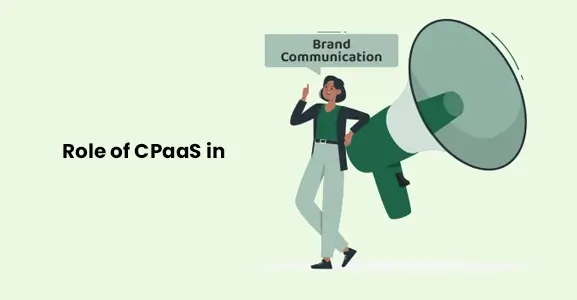
Nov 13, 2024
What Is Brand Communication? CPaaS Role Explained
Did you ever wonder why some advertisements grab your attention instantly, while others do not? The... Read More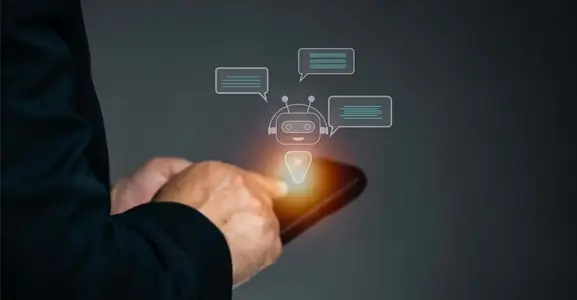
Nov 01, 2024
What Is Automated Messaging And How Does It Work?
Automated messaging or text automation empowers businesses and marketing professionals to connect wi... Read MoreLatest Updates
From Fonada
Industry Insights, Trends, Innovations, Updates, and Case Studies from Industry Experts
View
Customer
Reviews
Discover why our customers love us - read their authentic and heartfelt reviews!
View
Case
Studies
Explore real-life scenarios, offering analysis, and solutions to practical challenges
View
Convert Leads Into Sales With Fonada
Trusted CPaaS Solution Provider

